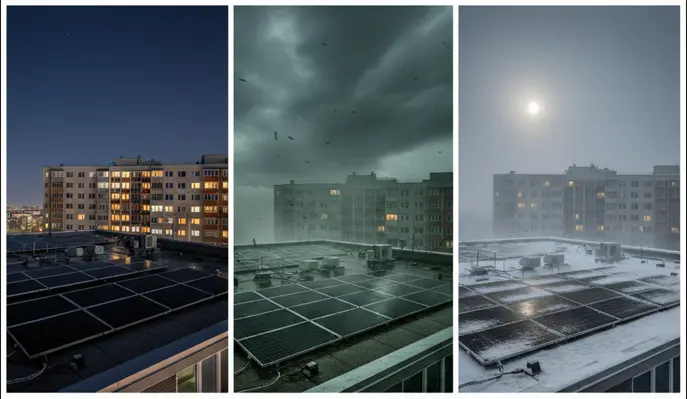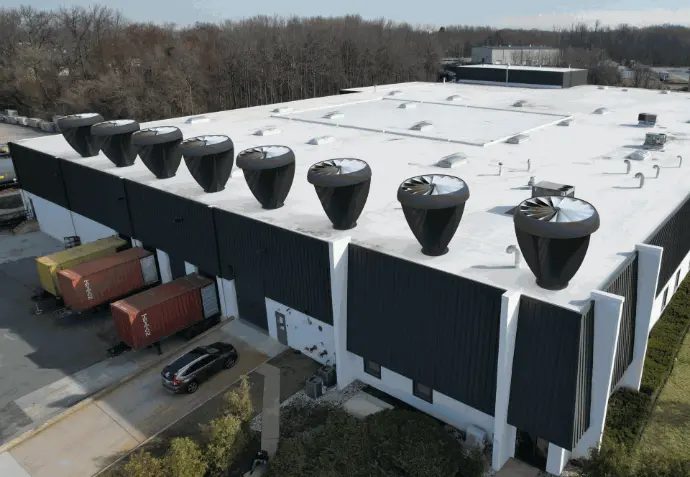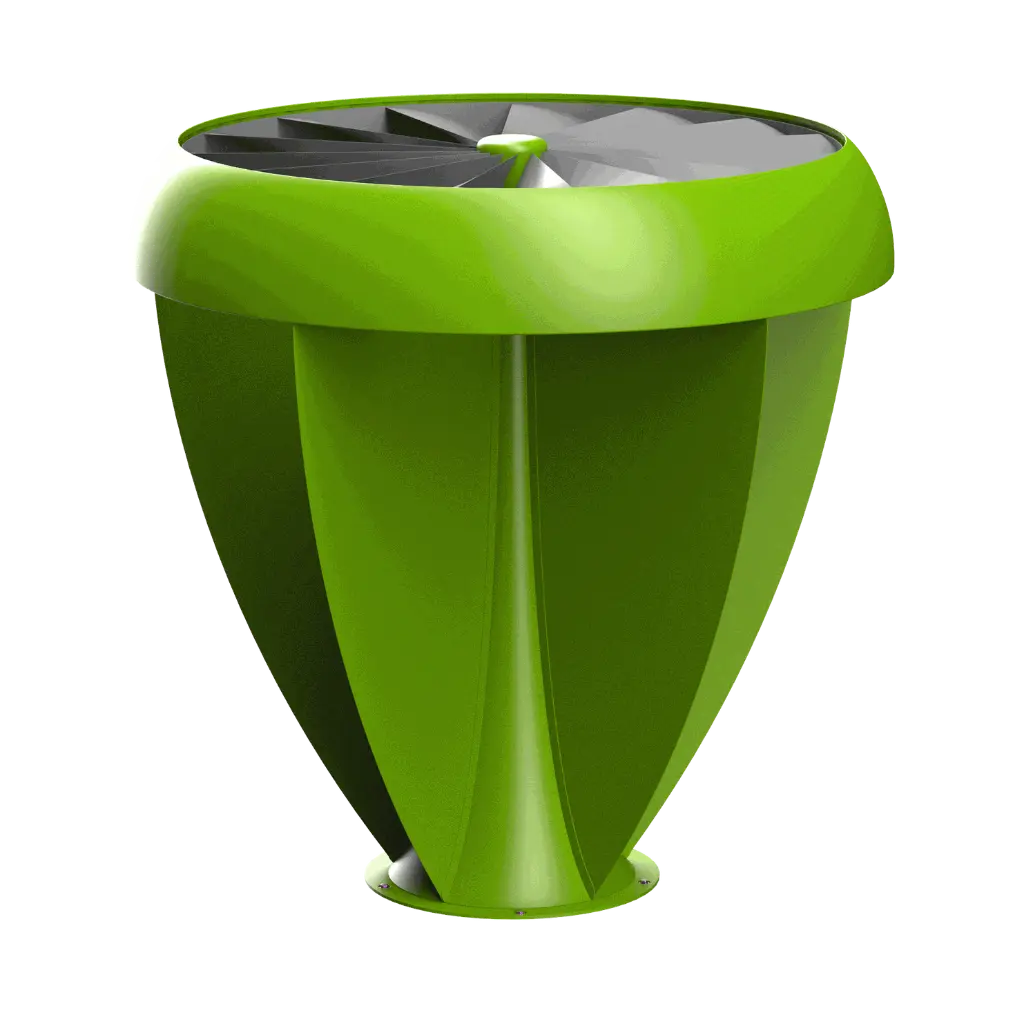ROOFTOP WIND
Solar's Missing Piece

Achieving 24/7
Rooftop Energy
Solar power is the cornerstone of rooftop energy. However, its production follows natural, predictable patterns.
Daily Cycles: Solar generation peaks at midday and ceases at night, leaving a 12+ hour gap in production.
Seasonal Shifts: Output is highest during the long, sunny days of summer but significantly lower during the shorter, often cloudier days of winter.
Weather Dependent: Production is dramatically reduced cloud cover and storms that are common in many regions.
This isn't a flaw, it's a known issue. While storage is a promising solution, there's also a clear opportunity to also create a high power rooftop power generation solution that complements solar.


Wind: The Natural Complement
Wind and solar are a natural fit, generating power at different times and in different conditions:
Power Through the Night: Wind often remains active after sunset, generating power throughout the night and closing solar's largest production gap.
Thrives in Stormy Weather: The same storms that eliminate solar production are the conditions that drive wind turbine's to produce its peak power.
Balances the Seasons: In many regions, winter months are windier. A wind turbine's output naturally rises just as solar's output declines, creating a more consistent year-round energy profile.
The Problem With Wind
Current rooftop wind turbines are nascent for three reasons:
Turbulent Wind: Wind flow in cities is highly turbulent, which damages open blades and significantly reduces energy capture.
Dangerous Blades: Exposed, fast-spinning rotors present an unacceptable safety hazard for people and wildlife.
Aesthetic Issues: The visual clutter (obnoxious flicker) are typically prohibitive in dense areas.
These primary concerns have made rooftop wind energy prohibitive in most towns and cities.


Made for Cities
Our design attempts to address these challenges by employing a shrouded enclosure.
- Aerodynamic shell: To manage the turbulent airflow, channeling it to potentially augment power generation beyond a traditional turbine in the same spot.
- Shrouded blades: Blades are secured behind a stationary outer shell. This significantly enhances safety for nearby people and wildlife.
- Minimized Visual Clutter: The integrated, stationary outer shell significantly reduces visible movement (flicker), allowing aesthetic integration into city architecture. While beauty is subjective, it's also important to us.
The Science
Bernoulli's Principle
This is a key concept in fluid dynamics that relates pressure and velocity of fluids (air is a fluid). When wind encounters a building, it builds up positive pressure along the face. Incoming wind avoids this by moving upwards towards the roof, where a low pressure system forms. High pressure pushes while the low pressure pulls, forcing incoming air to concentrate and accelerate. Wind power is highly dependent on speed, turning the building into a major advantage.
Venturi Effect
The Venturi Effect is a real-life application of Bernoulli's Principle. This happens when the now the accelerated and concentrated wind meets our turbine on the roof. The fins collect incoming wind and funnel it into the enclosed blade, further concentrating and accelerating it. Again, more speed, more kinetic energy. This is a well-understood and proven concept. Kinetic energy is increased at the expense of pressure potential energy, conserving total energy.
Potentially More Power
Power generation in wind turbines is governed by the equation P = ½ρAv³. As velocity (v) increases, power increases cubically (v³), meaning velocity is the king of wind power. The building and diffuser both create the possibility of increasing mass flow rate through the rotor and generating more power than the ambient wind speed and rotor size would otherwise be able to.
Challenges Ahead
We're entering the late and hopefully final stage of R&D where several challenges will hopefully be solved. Those challenges are:
- Nacelle Efficiency: The final power output depends on how well our 3rd party engineers able to translate the principles above into real power via the shell, blade, and generator. Much will depend on the skill and experience of our engineers.
- Off-Axis Flow: Turbulent city wind rarely approaches the roof from a single, consistent angle. Our turbine must prove its ability to maintain performance in highly variable, multi-directional flow.
- Betz's Limit: Betz's limit is the maximum energy available in wind for a turbine to harvest. Shrouded turbines can appear to exceed this limit when combined with all the elements that ours does, but they must be professionally designed to turn that potential into actual electricity and then vetted by qualified independent 3rd parties.

Meeting the Challenges
I believe the best way forward is to engage highly qualified third-party engineers with extensive experience in aeronautics. I feel we're building the right team and expect to have more to announce in this regard soon.
We are a startup with a novel product trying to succeed in a difficult environment where many are either struggling or have failed. At least one more round of development will be needed which is why choosing the right partner is so important. The risks are real, but we're excited for the challenge ahead.
I hope to release a product roadmap based on the proposal from our engineering partner once an agreement is finalized. I look forward to sharing more details as they become available.
This contains forward-looking statements, including, but not limited to, statements concerning our business strategy, the performance of our technology, market opportunity, and future plans. Words such as “expect,” “believe,” “project,” “plan,” “positioned to,” and similar expressions are intended to identify forward-looking statements.
These statements are based on our management's current beliefs and assumptions and are not guarantees of future performance. They are subject to known and unknown risks, uncertainties, and other factors that could cause our actual results to differ materially from those expressed or implied by these statements. A comprehensive discussion of these risks will be included in our Form C offering statement should we proceed with an offering. We undertake no obligation to update any forward-looking statements to reflect events or circumstances after the date of this email. Investors are cautioned not to place undue reliance on these forward-looking statements.
The above contains renderings of a future product. Images are computer-generated demo versions. Product is still currently under development and is not yet available on the market.
This Reg CF offering is made available through StartEngine Primary, LLC. This investment is speculative, illiquid, and involves a high degree of risk, including the possible loss of your entire investment.